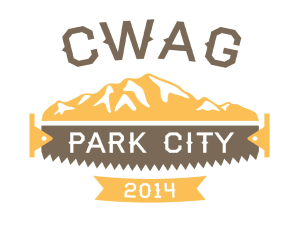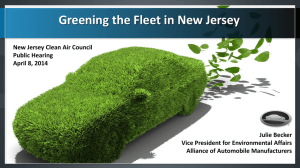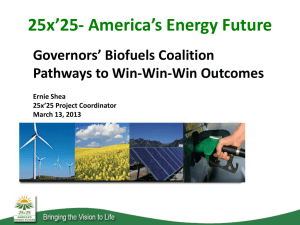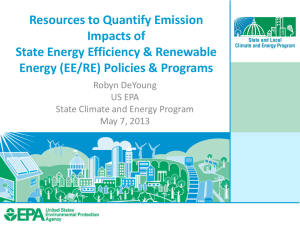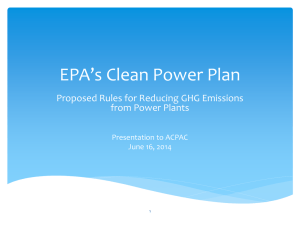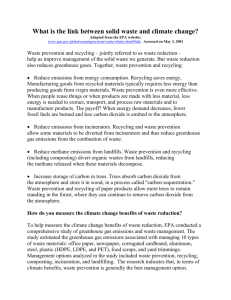PART 2 –Summary of Environmental Impacts
advertisement
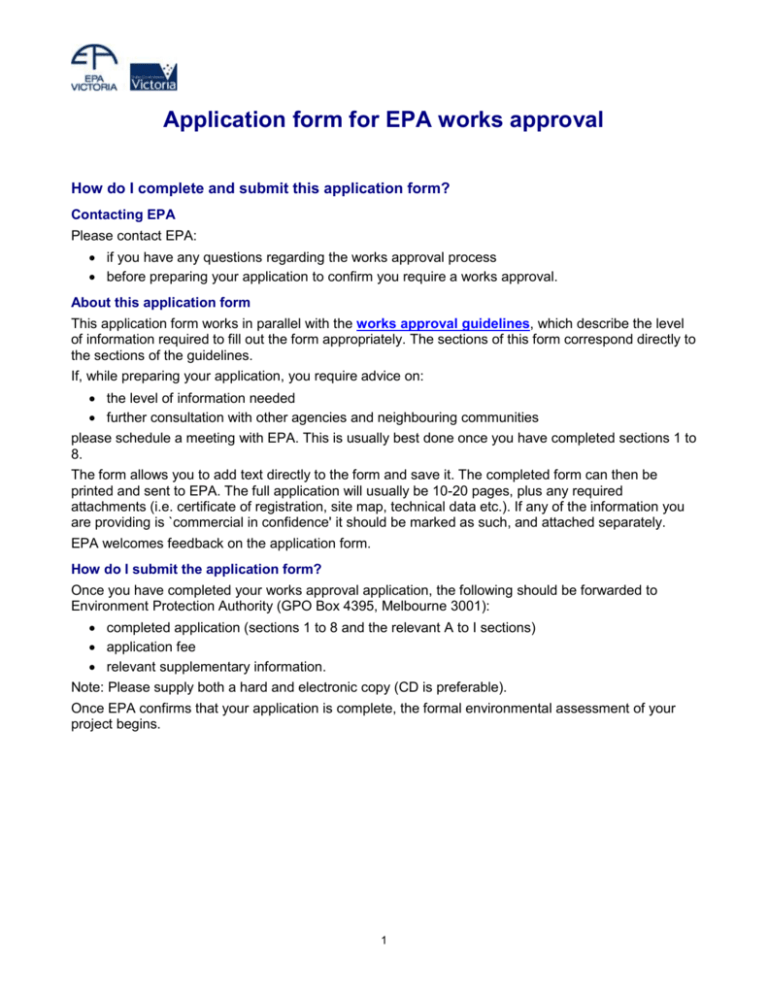
Application form for EPA works approval How do I complete and submit this application form? Contacting EPA Please contact EPA: if you have any questions regarding the works approval process before preparing your application to confirm you require a works approval. About this application form This application form works in parallel with the works approval guidelines, which describe the level of information required to fill out the form appropriately. The sections of this form correspond directly to the sections of the guidelines. If, while preparing your application, you require advice on: the level of information needed further consultation with other agencies and neighbouring communities please schedule a meeting with EPA. This is usually best done once you have completed sections 1 to 8. The form allows you to add text directly to the form and save it. The completed form can then be printed and sent to EPA. The full application will usually be 10-20 pages, plus any required attachments (i.e. certificate of registration, site map, technical data etc.). If any of the information you are providing is `commercial in confidence' it should be marked as such, and attached separately. EPA welcomes feedback on the application form. How do I submit the application form? Once you have completed your works approval application, the following should be forwarded to Environment Protection Authority (GPO Box 4395, Melbourne 3001): completed application (sections 1 to 8 and the relevant A to I sections) application fee relevant supplementary information. Note: Please supply both a hard and electronic copy (CD is preferable). Once EPA confirms that your application is complete, the formal environmental assessment of your project begins. 1 Application form for EPA works approval 1. APPLICANT 1.1 Company details Company name ACN Registered address 1.2 Contact details Name Position Phone Email 1.3 Premises details Premises address 2. PROPOSAL 2.1 Project description Municipality Provide a simple, one-line explanation of the project. Attach a site and location plan. 2.2 Cost of works and application fee Cost of works 2.3 Application fee Proposed dates Start construction: Month, Year 3. APPROVALS 3.1 Need for works approval Start operation: Month, Year Schedule type Act section that applies 19A (1)(a), (1)(b), (1)(c), (1)(d), (1)(e) List any exemptions that apply: section of the Regulations 2 Application form for EPA works approval 3.2 Planning and other approvals Planning Zone Type of approval required Approving authority Approval received or pending 3.3 Existing EPA approvals (if any) List any EPA documents held 4. ENVIRONMENT AND COMMUNITY 4.1 Track record Summarise the company’s recent environmental performance Report any relevant offences; e.g. indictable and summary offences List any enforcement actions related to this site 4.2 Key environmental considerations List the main environmental aspects of your proposal 4.3 Community engagement Summarise any public consultation that has been undertaken or planned Indicate any issues that have been raised 5. PROCESS AND BEST PRACTICE 5.1 Process and technology Key process steps 5.2 Key inputs Key outputs Environmental best practice Indicate steps taken to determine industry best practice 3 Key Controls Application form for EPA works approval Explain why waste generation and resource use cannot be avoided or minimised Explain options considered and why this process is considered best practice 5.3 Integrated environmental assessment Indicate any areas where there are competing environmental demands Indicate how you will determine net environmental benefit in these areas 5.4 Choice of process and technology Process or technology 5.5 Disadvantages Choice of location and layout Location or layout 5.6 Advantages Advantages Disadvantages Consideration of climate change impacts Indicate any areas of risk exposure from climate change and uncertainty in environmental condition 6. RESOURCES 6.1 Energy Type of energy use and associated greenhouse gas emission 6.2 Amount in GJ/yr and tCO2-e Water use The water usage: ML per year 6.3 Solid waste Type of solid waste Amount t/yr Destination 4 Application form for EPA works approval 6.4 Prescribed industrial waste Type of prescribed waste 7. EMISSIONS 7.1 Air emissions Type of air emissions 7.2 Amount t/yr Destination Rate or scale of emissions List any class 3 indicators Discharge to surface water Provide reasons for any discharge to water (rather than to sewer or to land) Rate of discharge to water; litres per day 7.3 Indicate water quality or treatment level Discharge to land Rate of discharge or deposit to land, litres/or tonnes per day Types of waste and level of treatment e.g. secondary or tertiary For reuse, demonstrate that the proposal will meet EPA guidelines Provide the reasons for any discharge to groundwater and indicate segment 7.4 Noise emissions Hours of operation 7.5 Noise sources Are they audible at nearby residences? Greenhouse gas emissions Scope of emissions Rate or scale of emissions 5 Expected changes over time Application form for EPA works approval 8. ENVIRONMENTAL MANAGEMENT 8.1 Non-routine operations and climate change impacts List process upsets that could impact on the environment List any uncertainty in future environmental conditions that could result in process upsets 8.2 Separation distances Proposed buffer distances, in metres 8.3 Recommended buffer distance, in metres Management system Explain the system that will be used to manage environmental risk 8.4 Construction Identify any environmental risks that will need to be managed during installation Identify any existing site contamination issues Explain how construction will be managed to prevent environmental impacts 6 Application form for EPA works approval A. ENERGY AND GREENHOUSE GAS EMISSIONS A1. Energy use and greenhouse gas emissions Note any existing energy use and greenhouse gas emissions Process step Type of energy use or greenhouse gas Amount (TJ/year) or tCO2e/year Basis for numbers A2. Best practice energy and greenhouse gas management Outline the steps taken to identify best practice energy and greenhouse gas management Summarise the options considered to avoid or minimise greenhouse gas emissions Explain why the chosen option is best practice B. WATER B1. Water use Note any existing water use Process step Type of water use Basis for numbers B2. Best practice water management Outline the steps taken to identify best practice for saving water Summarise the options considered to avoid or minimise water usage Explain why the chosen option is best practice 7 Amount (ML/year) Application form for EPA works approval C. SOLID WASTE C1. Solid waste generation Note any existing solid waste generation Process step Type of waste generated Amount (t/year) Basis for numbers C2. Best practice solid waste management Outline the steps taken to identify best practice for solid waste management Summarise the options considered to avoid or minimise solid waste Explain why the chosen option is best practice Indicate where these wastes will go D. PRESCRIBED INDUSTRIAL WASTE D1. Prescribed industrial waste generation Note any existing prescribed industrial waste generation Process Type of waste Waste category Basis for numbers D2. Best practice prescribed waste management Outline the steps taken to identify best practice for prescribed waste Summarise the options considered to avoid or minimise prescribed waste Explain why the chosen option is best practice Indicate where these wastes will go 8 Amount (t/year) Application form for EPA works approval E. AIR E1. Air emissions Note any existing air emissions Process step Type of air emission* Amount (g/min) *Identify any class 3 indicator emissions Basis for numbers E2. Best practice air emissions management Outline the steps taken to identify best practice# for air emissions Summarise the options considered to avoid or minimise air emissions Explain why the chosen option is best practice# # For class 3 indicator emissions assess against maximum extent achievable E3. Impact on air quality Predicted maximum concentration (project) Background concentration Predicted maximum concentration (total)^ Desig ^ Where any predicted concentrations are above the design criteria, provide a risk assessment. Assess any emissions that could impact on regional air quality. F. WATER F1. Water discharges Note any existing water discharges Process step Type of water discharge Basis for numbers 9 Flowrate (L/day) Application form for EPA works approval F2. Best practice water management Outline the steps taken to identify best practice for discharge to water Summarise the options considered to avoid or minimise water discharges Explain why the chosen option is best practice F3. Impact on waterway Indicator Maximum concentration Median concentration (mg/L) Water quality objective ^ ^ Where any predicted concentrations are above the objectives, provide a mixing zone assessment G. LAND AND GROUNDWATER G1. Discharge or deposit to land Note any existing discharge or deposit to land Process step Type of discharge Flow rate (L/day) Or Type of waste Amount (t/year) Basis for numbers G2. Best practice land and groundwater management Outline the steps taken to identify best practice in discharge or deposit to land Summarise the options considered to avoid or minimise discharge to land For landfills, demonstrate best practice siting and design 10 Application form for EPA works approval Explain why the chosen option is best practice G3. Impact on land and groundwater Provide a land capability assessment Groundwater Indicator Predicted Concentration Water quality objective^ ^ Where any predicted concentrations are above the objectives, provide an attenuation zone assessment Assess any impacts on the level of the water table H. NOISE EMISSIONS H1. Noise emissions Process step Source/type of emission Sound power level (dBA) Basis for numbers H2. Best practice noise management Outline the steps taken to identify best practice for noise emissions Summarise the options considered to avoid or minimise noise emissions Explain why the chosen option is best practice H3. Noise impact Location of receptor(s) Noise levels from project^ Existing noise levels (site)^ Total noise level^ Background noise level^ Noise limit^ ^ dBA for each of day, evening and night where relevant. Where existing site noise is above the limit, provide a noise reduction plan. 11 Application form for EPA works approval I. ENVIRONMENTAL MANAGEMENT I1. Non routine operations Outline the steps taken to identify potential process upsets or failures Outline approach to identifying best practice in managing these environmental risks Type of process upset Potential environmental impact Measures to reduce likelihood and impact Explain why the buffer distance to residents is acceptable I2. Climate change uncertainty Outline the steps taken to identify potential risks from climate change Outline approach to identifying best practice in managing these risks I3. Monitoring Process Indicator Measured Monitoring type Monitoring frequency Use of monitoring APPLICANT STATEMENT I declare that to the best of my knowledge the information in this application is true and correct, that I have made all the necessary enquiries and that no matters of significance have been withheld from EPA. Signed CEO or delegate 12

